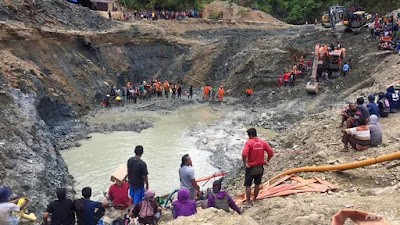Six people have been confirmed dead, fifteen have been dug out alive, and one is still missing following a landslide at an illegal gold mine in the village of Buranga in Central Sulawesi, Indonesia, on Thursday 24 February 2021. The landslide is thought to have been caused by a combination of heavy rainfall associated with the the Northeast Monsoon, according to Fatmawati, a spokeswoman for the Badan Nasional Penanggulangan Bencana. Landslides are a common problem after severe weather events, as excess pore water pressure can overcome cohesion in soil and sediments, allowing them to flow like liquids. Approximately 90% of all landslides are caused by heavy rainfall.
Rescue workers at an illegal gold mine in Central Sulawesi, following a landslide on 25 February 2021. AFP.
Indonesia's large size, mineral richness, and poor population make unlicensed mining a widespread problem in the country, with illegal mines typically dug with hand tools and located in remote locations where authorities are unlikely to spot them (though some such operations are larger and more blatant in nature). Such mines tend to take few health and safety precautions, and are often dug by people with only a limited understanding of the structural geology of the area, making accidents extremely common, in many cases without help ever arriving due to the hidden nature of the mines. Such mines also present an environmental threat, producing waste which is often toxic, and contributing to deforestation, which can destabilise hillslopes, placing the miners at further risk.
Monsoons are tropical sea breezes triggered by heating of the land during the warmer part of the year (summer). Both the land and sea are warmed by the Sun, but the land has a lower ability to absorb heat, radiating it back so that the air above landmasses becomes significantly warmer than that over the sea, causing the air above the land to rise and drawing in water from over the sea; since this has also been warmed it carries a high evaporated water content, and brings with it heavy rainfall. In the tropical dry season the situation is reversed, as the air over the land cools more rapidly with the seasons, leading to warmer air over the sea, and thus breezes moving from the shore to the sea (where air is rising more rapidly) and a drying of the climate.
Sulawesi has two distinct Monsoon Seasons, with a Northeast Monsoon driven by winds from the South China Sea that lasts from November to February and a Southwest Monsoon driven by winds from the southern Indian Ocean from March to October. Such a double Monsoon Season is common close to the equator, where the Sun is highest overhead around the equinoxes and lowest on the horizons around the solstices, making the solstices the coolest part of the year and the equinoxes the hottest.
Indonesia, and other countries of the western Pacific margin, are experiencing a particularly wet year, due to a prevailing La Niña weather system over the Pacific. The La Niña weather system is the opposite of the El Niño weather system, in which unusually cold surface temperatures spread across the equatorial Pacific from the upwelling zone on the South American coast. This traps warm water from the western Pacific, preventing it from spreading east and warming the central Pacific. This leads to lower evaporation over the (cooler) east Pacific, leading to low rainfall on the west coast of South America, and higher evaporation over the (warmer) west Pacific, leading to higher rainfall over East and Southeast Asia and northern Australia.
See also...



Follow Sciency Thoughts on Facebook.
Follow Sciency Thoughts on Twitter.








